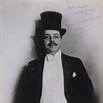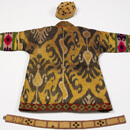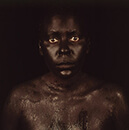
“In the Conservatory,” with costume nearby
I read about the show, Impressionism, Fashion, and Modernity, which just closed at the Metropolitan Museum of Art (it will open at the Chicago Art Institute on June 25), months ago when it was still on at the Musee d’Orsay in Paris and, being a sucker for costume, knew I had to see it once all those bustles sashayed into New York.
It was great fun, seeing those dresses on manikins standing near paintings by Manet, Monet, Renoir, and my beloved James McNeill Whistler, to name a few. Such close picks, the costumes looked as if they’d come to life in the paintings. “In the Conservatory,” 1881, shows a charming Mme. Bartolome, painted by her husband, her face in shadow, standing in the cool of a conservatory doorway, lilacs in bloom in the garden behind her, wearing a complicated purple and white dress. And there the actual dress is, beautifully preserved and impossibly small-waisted.

“Young Lady,” by Edouard Manet, 1866
It’s huge show, full of delights, but seeing the clothes worn in some of my favorite paintings was the biggest treat. To begin with, Manet’s “Young Lady,” 1866: Here she stands, daintily sniffing violets, wearing the palest pink duster, a cameo at her throat. Improbably, a parrot roosts on a pedestal before her. That shell pink wrapper, her demure gaze glazed with a hint of seduction, is an exotic drawing room moment.
A new painting, but one with quite a wallop, was James Tissot’s 1864 “Portrait of Mlle. L. L,” an Anne Hathaway look-alike. Mille. LL wears a lipstick-red, ball-fringe-trimmed bolero jacket, popularized by the Empress Eugenie of Spain, a fashionista in her own right. With her frank gaze at the viewer, having ditched the crinolines, her look is strikingly modern.

“Women in the Garden,” by Claude Monet, 1866
Monet’s “Women in the Garden,” 1866, is so full of life you feel you could join these lovely ladies dashing about or merely sitting, enjoying the summer day. Monet achieved a radical angle for the painting by digging a ditch and climbing into it with his canvas and paints. The effects of light and shadow reveal the love Monet felt for three of the sitters, all images of his soon-to-be wife, Camille.

“Luncheon on the Grass,” fragments, by Claude Monet, 1865-66, with costumes
Only fragments remain of Monet’s “Luncheon on the Grass,” 1865. This was to have been a 20-foot painting showing the most stylishly garbed Parisians imaginable. What is left is a charming portrait of seven life-sized figures, sitting, standing walking, in dappled sunlight. Once again you’re struck by the utter modernity of these figures and how familiar they look. Sadly, the better part of the work succumbed to a landlord’s damp basement when the artist failed to pay the rent.
“The latest fashion . . . is absolutely necessary for a painting. It’s what matters most,” Edouard Manet declared at around the time that fashion was popularized in department stores and their racks of “pret a porter” numbers. Paris became not only the incubator of modern impressionist painting, but also the fashion capital of the world. Memorabilia included here attest to that fact: fashion photographs, catalogues, hand colored engravings of swanky folks, the women’s enormous skirts like upside down mushrooms. Accessories include: fans, gloves, parasols, shoes, teeny kid gloves, and wince-inducing corsets.

“The Parisienne,” by Edouard Manet, 1875
“Black is the queen of colors,” so said Auguste Renoir, and when we come to the black room, we believe him. Berthe Morisot’s 1875 “Figure of a Woman (Before the Theater)” and Manet’s “The Parisienne,” 1875, draw you in, but a large portrait of Ellen Andree (she was Degas’ model for “The Absinthe Drinkers”) in black knocks your socks off. She, a former department sales girl, wears, as the accompanying wall placard says, “the riding habit of an amazone,” and she’s fully up to the name. Nearby, a nearly identical and equally splendid costume is displayed.

“Portrait of Manet,” by Fantin-Latour, 1867
Lest you think men have gotten short shrift here, one large room is devoted to the metro-sexual fellow of the day—top hats, a wool Derby, and a straw boater are as crisp as can be. Canes fill another case. Caillebotte’s 1880 “At the Café,” shows a fellow of dubious character, while Fantin-Latour’s 1867 portrait of Manet, shows us an elegant bon vivant, no bohemian artist, he. Degas’ wonderful “Portraits at the Stock Exchange,” is a glimpse of everyday life at the Bourse, the angled top hats animating the picture. Whistler’s “Arrangement in Flesh Color and Black,” a portrait of Theodore Duret made in 1883, show a weary-looking gentleman, holding a women’s cape, as if waiting, not happily, for his wife to complete her toilette, or emerge from the ladies room. A 26-year-old Renoir painted with his feet up on the rungs of a chair by Bazille in 1867, looks disarmingly callow.

“At the Milliners,” by Edouard Manet, 1881
A room of hats and pictures capturing various milliner’s visits is especially delicious, particularly Manet’s “At the Milliners,” made in 1881, with its brilliant colors. We really should wear hats again!

“The Shop Girl,” by James Tissot, 1883
In a stand-out Tissot (1883-5), “The Shop Girl,” one of a series of fifteen paintings of “the women of Paris,” the shop girl smiles and holds the door for you, while a window-shopping man outside appears to flirt with another clerk.
A plum day dress by the House of Worth (1886) announces the return of the bustle, not the soft pear-shaped ones we’re more used to, but a jutting flying buttress of a bustle, to be worn on Hausmann’s broad boulevards, to see and be seen. The last room of the show is devoted to all the places one could be on display – the circus, the theater, the loge. Most importantly, one could be seen on the streets, as in Caillebotte’s famous 1877 “Paris Street, Rainy Day.”

“Paris Street, Rainy Day,” by Gustave Caillebotte, 1877
Anticipating today’s fashion when “street” often becomes couture, this show is a new vision of Paris at a time when fashion and art merged.























 Visit this jewel box of a museum to clear your mind and spirit while feasting on one of the world’s most stunning collections of 19th and 20th century paintings, sculpture and African and Asian art. The private collection of Carmen and David Kreeger is housed in a 1967 Phillip Johnson home, a work of art in itself, with its Byzantine domes, travertine limestone clad walls, and interior courtyard filled with towering tropical plants.
Visit this jewel box of a museum to clear your mind and spirit while feasting on one of the world’s most stunning collections of 19th and 20th century paintings, sculpture and African and Asian art. The private collection of Carmen and David Kreeger is housed in a 1967 Phillip Johnson home, a work of art in itself, with its Byzantine domes, travertine limestone clad walls, and interior courtyard filled with towering tropical plants. After passing through the grand salon (Picassos to the right of you, Braques to the left of you!), you’ll come to a magnificent stairway, its railing clad in molten bronze grill work. Each of the rectangles and parallelograms is a work of art, no two alike, like links in an enormous necklace. Please touch! Descend the staircase, passing a Calder mobile, to the lower gallery. Here you’ll enjoy Yves Tanguy, Man Ray, Jean Dubuffet, Frank Stella, among others. Knockouts include Sam Gilliam’s vibrant “Cape” (1969), and Gene Davis’ candy striped canvas, untitled, so you can make up your own (1953).
After passing through the grand salon (Picassos to the right of you, Braques to the left of you!), you’ll come to a magnificent stairway, its railing clad in molten bronze grill work. Each of the rectangles and parallelograms is a work of art, no two alike, like links in an enormous necklace. Please touch! Descend the staircase, passing a Calder mobile, to the lower gallery. Here you’ll enjoy Yves Tanguy, Man Ray, Jean Dubuffet, Frank Stella, among others. Knockouts include Sam Gilliam’s vibrant “Cape” (1969), and Gene Davis’ candy striped canvas, untitled, so you can make up your own (1953). backsides. Both are lovely.
backsides. Both are lovely.
 Other stand-out items include: Chuck Brown’s red leather jacket, a lurid poster for the movie “DC Cab,” skate boarders’ graffiti art notebooks, posters for a boxing match pitting Darryl “Too Sweet” Coley against Che “The Destroyer” Lars, and a “Gotta Go-Go” record jacket with a “Reagan Wants You” illustration.
Other stand-out items include: Chuck Brown’s red leather jacket, a lurid poster for the movie “DC Cab,” skate boarders’ graffiti art notebooks, posters for a boxing match pitting Darryl “Too Sweet” Coley against Che “The Destroyer” Lars, and a “Gotta Go-Go” record jacket with a “Reagan Wants You” illustration.